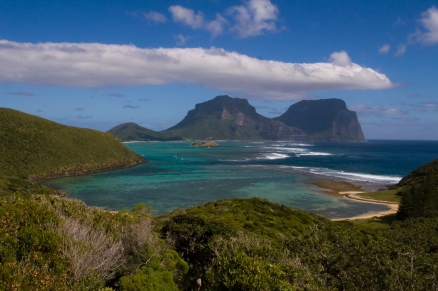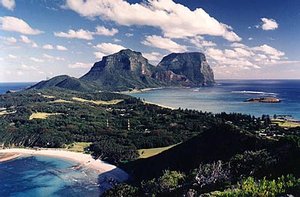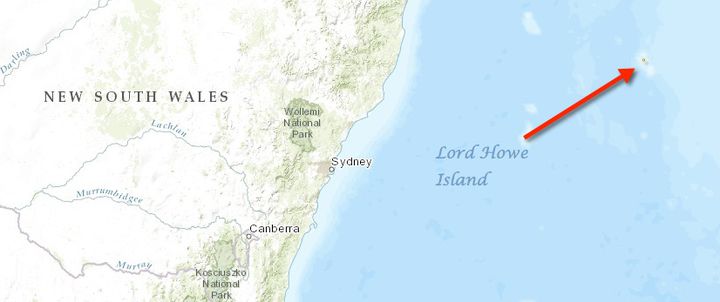Lord Howe Island subtropical forests
Introduction Lord Howe Island is unique among inhabited Pacific islands in that less than 10 percent of the island has been cleared (Lord Howe Island subtropical forests) for human use. Despite this, a large number of endemic birds are now extinct, and the native fauna is threatened by introduced (Exotic species) species (Exotic species). However, the majority of the island group is well preserved as a World Heritage Site and as the control of exotic animals continues, some regrowth of vegetation is occurring.
Location and General Description
Lord Howe Island is located approximately 700 kilometers (km) east of Australia and 1,350 km northwest of New Zealand (31S, 159E) on the submerged Lord Howe Rise. It is a 10 km long crescent-shaped remnant of a huge shield volcano that was formed about 6.9 million years ago as the Australian plate moved over a stationary hotspot. The volcano has now eroded into Lord Howe Island, the tiny islets of the Admiralty Group, and Ball’s Pyramid, an islet now separated from Lord Howe Island by 21 km of water. There are two main peaks on the southern end of Lord Howe Island, Mount Gower (875 meters) and Mount Lidgbird (777 meters). The climate is humid-subtropical, with a mean annual rainfall of 1,717 millimeters (mm). This rainfall is spread evenly throughout the year and enables the island to support a lush rain forest.
Lord Howe Island is largely covered with rain forest, although there are areas of scrub, grassland, and clearings in the lowlands and on the cliffs. The lowland rain forest is divided into five types: Drypetes-Cryptocarya, Cleistocalyx-Chionanthus, mixed broadleaf, Howea forsterana, or H. belmoreana palm forest, and pandan forest (Pandanus forsteri). Cryptocarya gregsonii and the palm Hedyscepe canterburyana dominate the submontane forest. The understory is rich with ferns, tree-ferns (Cyathea spp.), and mosses. Canopy dieback occurs in this forest and is thought to be a natural phenomenon related to cohort senescence. On the upper reaches of Mount Gower and Mount Lidgbird, there is true cloud forest, dominated by Zygogynum howeanum and Dracophyllum fitzgeraldii. This stunted, gnarled forest is an important haven for the endemic Lord Howe woodhen (Gallirallus sylvestris), and is used as a breeding ground by Providence petrels (Pterodoma solandri). In general, the forests of Lord Howe Island show strong affinities with the flora of Australia, New Caledonia, and, to a lesser extent, New Zealand.
Biodiversity Features
Due in part to its long isolation, the flora and fauna of Lord Howe Island show a high degree of endemism. Of the 241 native species of vascular plants, 105 are endemic species. There are 5 endemic plant genera: Negria, Lordhowea, and the palms Hedyscepe, Howea, and Lepidorrhachis. At least 16 of the endemic plant species are considered rare, endangered or vulnerable, and many have extremely restricted ranges: the endemic Chionochloa conspicua is known from a single clump on Mount Lidgbird.
There are currently 129 native and introduced (Exotic species) bird species in the islands, 27 of which breed regularly on Lord Howe. Nine of the original 15 native landbird species have gone extinct, including 7 endemic species.There are four extant endemic landbirds, including two species and two subspecies: the relatively abundant Lord Howe white-eye (Zosterops tephropleurus), the Lord Howe Island woodhen, Lord Howe Island golden whistler (Pachycephala pectoralis contempta), and the Lord Howe Island currawong (Strepera graculina crissalis). The woodhen was reduced to 25 individuals in the 1970s, but an intensive management program has boosted the population to more than 220 individuals. Seabirds use the islands as well, and one of the few known breeding grounds of the Providence petrel is in the cloud forest of Lord Howe Island. Approximately half of the world’s population of flesh-footed shearwater (Puffinus carneipes hullianus) breeds on the Island, and Lord Howe Island has the greatest concentration of red-tailed tropicbird (Phaethon rubricauda). Twelve other species of seabird also breed on the island. Not surprisingly, there is only one native mammal, the large forest bat (Eptesicus sagittula), and two native reptiles, a skink (Oligosoma lichenigera VU) and a gecko (Phyllodactylus guentheri), both of which may be extinct on the main island due to the effects of introduced predators. There are, however, many endemic invertebrate taxa in the subtropical forests, ranging from land snails to flies and earthworms. Of the 100 spider taxa described from Lord Howe, up to 50 percent are thought to be endemic. It is also worth noting that Lord Howe Island boasts the southernmost coral reef of any Pacific island, and that 4 percent of its fish taxa are shared only with Norfolk Island.
Current Status
Lord Howe’s geographical isolation led to the development of its unique flora and fauna. It also resulted in its persistence, in that the island was not settled until the early 19th century and has never supported a large human population. Only 10 percent of the land area has been cleared for human use, and an additional 20 percent of native vegetation has been disturbed by [[introduced (Exotic species)] animals], including cattle, feral sheep, goats, pigs, and rats. Most of the island is still forested, and 75 percent of the land area was declared a Natural World Heritage Site in 1982. The management of Lord Howe’s biological and cultural heritage is entrusted to the Lord Howe Island Board, which has been responsible for successfully eradicating goats from the islands and decimating feral pig populations. Efforts to control other introduced species such as rats, mice, and a variety of weeds are ongoing. The removal of feral animals has resulted in the recovery of forest understory on Lord Howe Island.
Types and Severity of Threats
Although most of Lord Howe Island is now protected, continued vigilance is needed to prevent the introduction and naturalization of exotic species. Introduced predators have had a devastating effect of the endemic land fauna, and introduced weeds are invading the islands and displacing native species. Continued control of existing exotics is an integral step in promoting the recovery of Lord Howe Island’s many threatened species.
Justification of Ecoregion Delineation
Includes the ‘Lord Howe Island’ EBA. Part of ‘Norfolk and Lord Howe Islands’ CPD.
Additional Information on this Ecoregion
- For a shorter summary of this entry, see the WWF WildWorld profile of this ecoregion.
- To see the species that live in this ecoregion, including images and threat levels, see the WWF Wildfinder description of this ecoregion.
- World Wildlife Fund Homepage
Further Reading
- Australian National Parks and Wildlife Service. 1981. Nomination of the Lord Howe Island Group for inclusion in the World Heritage List. New South Wales Government, Sydney.
- Davey, A. 1986. Plan of management: Lord Howe Island Permanent Park Preserve. New South Wales National Parks and Wildlife Service, Sydney.
- DEST/ERIN. 1995. Lord Howe Island Group. Managed Area Report. Department of the Environment, Australia.
- Disney, H.J. and Smithers, C.N. 1972. The Distribution of Terrestrial and Freshwater Birds on Lord Howe Island, in comparison with Norfolk Island. The Australian Zoologist 17(1).
- Hilton-Taylor, C. 2000. 1998. The IUCN 2000 Red List of Threatened Species. IUCN, Gland, Switzerland and Cambridge, United Kingdom. ISBN: 2831705657
- McDougall, I., Embleton, B.J.J., and Stone, D.B. 1981. Origin and evolution of Lord Howe Island. Southwest Pacific Ocean: Journal of the Geological Society of Australia, 28: 155-176.
- Miller, B. and Kingston, T. 1980. Lord Howe Island Woodhen. Endangered Species of New South Wales. National Parks and Wildlife Service.
- Mueller-Dombois, D. and F. R. Fosberg. 1998. Vegetation of the tropical Pacific islands. Springer-Verlag, New York, Inc. ISBN: 038798285X
- Recher, H.F. and Clark, S.S. 1974. A biological survey of Lord Howe Island with recommendations for the conservation of the island's wildlife. Biological Conservation 6(4): 263-273.
- Stattersfield, A. J., M. J. Crosby, A. J. Long, and D. C. Wedge. 1998. Endemic Bird Areas of the World. Priorities for biodiversity conservation. BirdLife Conservation Series No. 7. BirdLife International, Cambridge, United Kingdom.
- WCMC. 1996. Lord Howe Island Group. WCMC Database of Protected Areas.
| Disclaimer: This article is taken wholly from, or contains information that was originally published by, the World Wildlife Fund. Topic editors and authors for the Encyclopedia of Earth may have edited its content or added new information. The use of information from the World Wildlife Fund should not be construed as support for or endorsement by that organization for any new information added by EoE personnel, or for any editing of the original content. |


